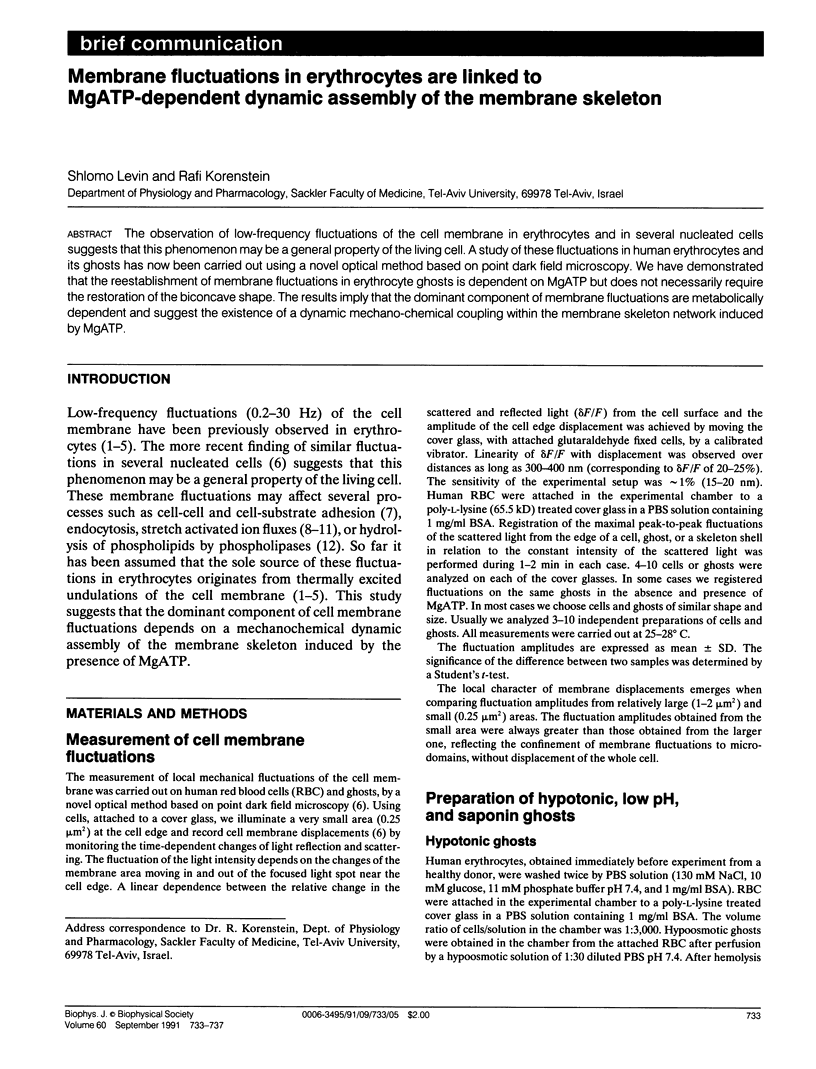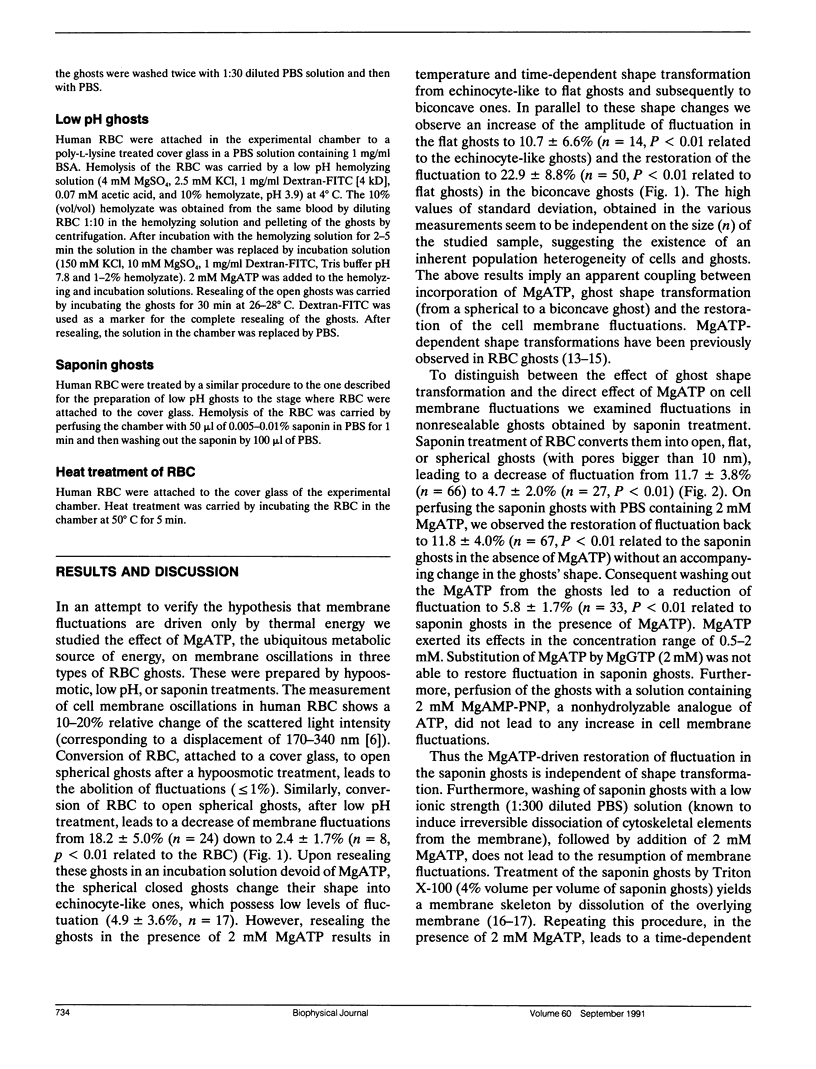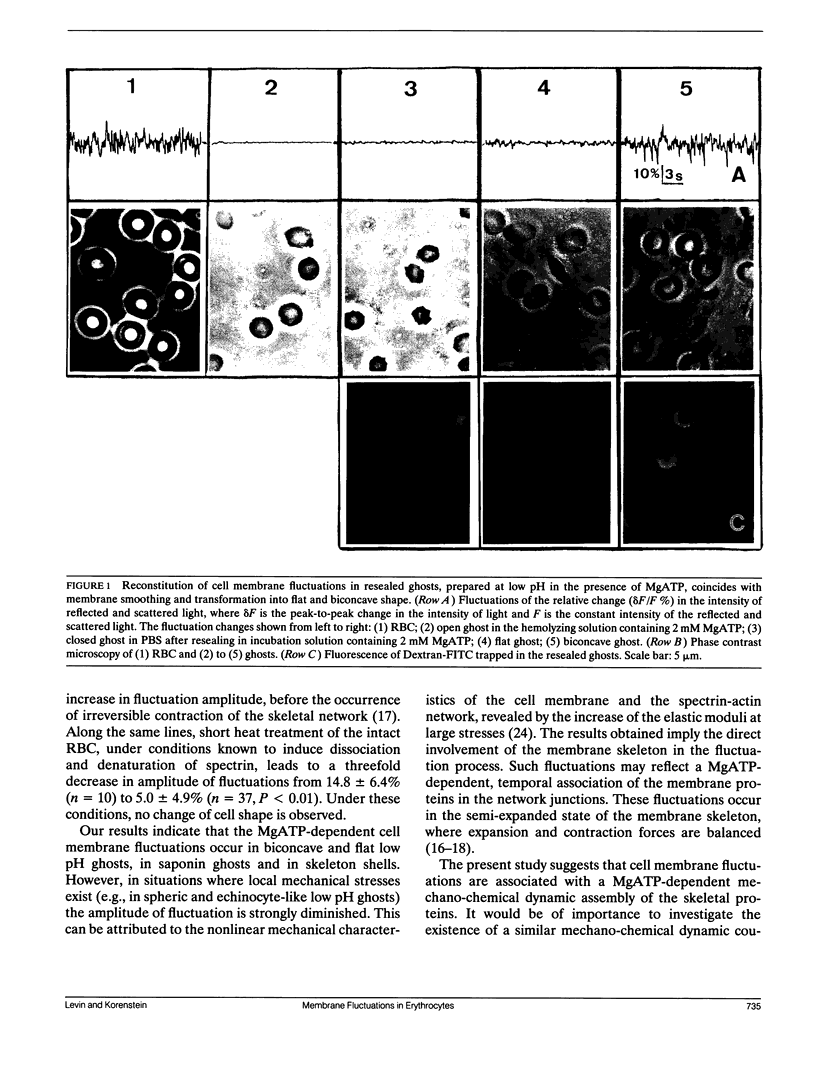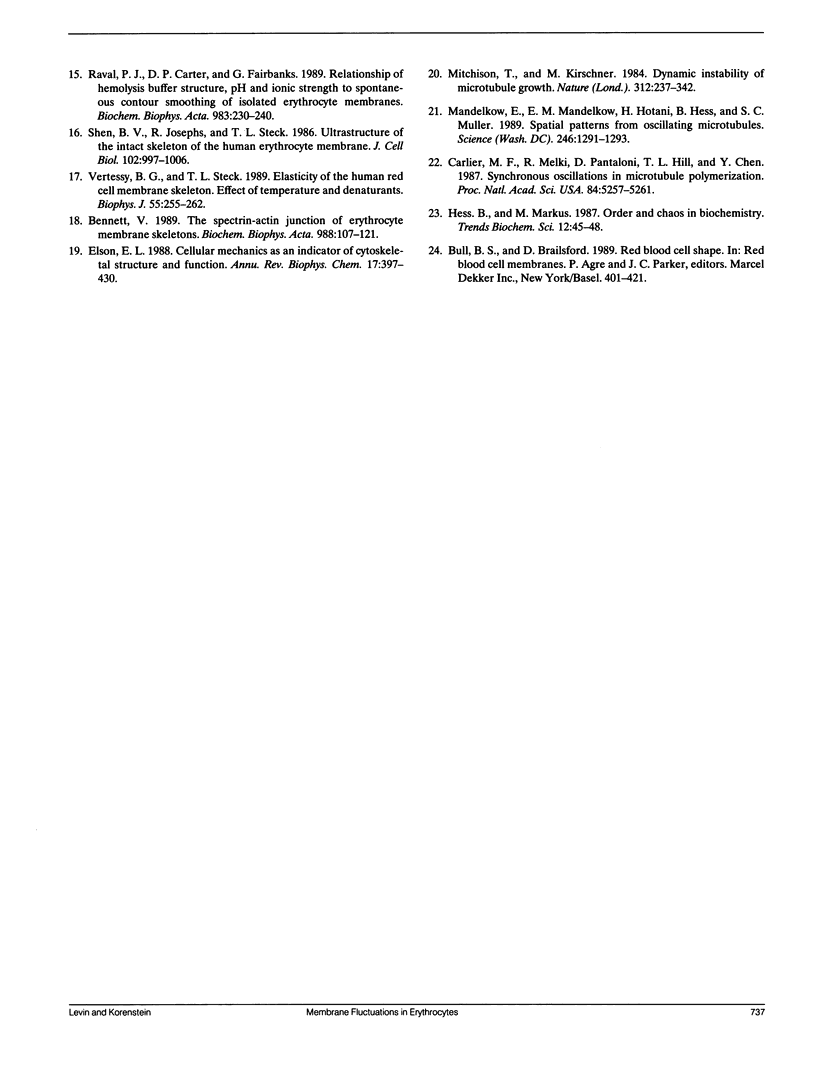Abstract
The observation of low-frequency fluctuations of the cell membrane in erythrocytes and in several nucleated cells suggests that this phenomenon may be a general property of the living cell. A study of these fluctuations in human erythrocytes and its ghosts has now been carried out using a novel optical method based on point dark field microscopy. We have demonstrated that the reestablishment of membrane fluctuations in erythrocyte ghosts is dependent on MgATP but does not necessarily require the restoration of the biconcave shape. The results imply that the dominant component of membrane fluctuations are metabolically dependent and suggest the existence of a dynamic mechano-chemical coupling within the membrane skeleton network induced by MgATP.
Full text
PDF




Images in this article
Selected References
These references are in PubMed. This may not be the complete list of references from this article.
- Bennett V. The spectrin-actin junction of erythrocyte membrane skeletons. Biochim Biophys Acta. 1989 Jan 18;988(1):107–121. doi: 10.1016/0304-4157(89)90006-3. [DOI] [PubMed] [Google Scholar]
- Carlier M. F., Melki R., Pantaloni D., Hill T. L., Chen Y. Synchronous oscillations in microtubule polymerization. Proc Natl Acad Sci U S A. 1987 Aug;84(15):5257–5261. doi: 10.1073/pnas.84.15.5257. [DOI] [PMC free article] [PubMed] [Google Scholar]
- Elson E. L. Cellular mechanics as an indicator of cytoskeletal structure and function. Annu Rev Biophys Biophys Chem. 1988;17:397–430. doi: 10.1146/annurev.bb.17.060188.002145. [DOI] [PubMed] [Google Scholar]
- Evans E. A., Parsegian V. A. Thermal-mechanical fluctuations enhance repulsion between bimolecular layers. Proc Natl Acad Sci U S A. 1986 Oct;83(19):7132–7136. doi: 10.1073/pnas.83.19.7132. [DOI] [PMC free article] [PubMed] [Google Scholar]
- Fricke K., Sackmann E. Variation of frequency spectrum of the erythrocyte flickering caused by aging, osmolarity, temperature and pathological changes. Biochim Biophys Acta. 1984 Mar 23;803(3):145–152. doi: 10.1016/0167-4889(84)90004-1. [DOI] [PubMed] [Google Scholar]
- Fricke K., Wirthensohn K., Laxhuber R., Sackmann E. Flicker spectroscopy of erythrocytes. A sensitive method to study subtle changes of membrane bending stiffness. Eur Biophys J. 1986;14(2):67–81. doi: 10.1007/BF00263063. [DOI] [PubMed] [Google Scholar]
- Guharay F., Sachs F. Stretch-activated single ion channel currents in tissue-cultured embryonic chick skeletal muscle. J Physiol. 1984 Jul;352:685–701. doi: 10.1113/jphysiol.1984.sp015317. [DOI] [PMC free article] [PubMed] [Google Scholar]
- Krol AYu, Grinfeldt M. G., Levin S. V., Smilgavichus A. D. Local mechanical oscillations of the cell surface within the range 0.2-30 Hz. Eur Biophys J. 1990;19(2):93–99. doi: 10.1007/BF00185092. [DOI] [PubMed] [Google Scholar]
- Lichtenberg D., Romero G., Menashe M., Biltonen R. L. Hydrolysis of dipalmitoylphosphatidylcholine large unilamellar vesicles by porcine pancreatic phospholipase A2. J Biol Chem. 1986 Apr 25;261(12):5334–5340. [PubMed] [Google Scholar]
- Mandelkow E., Mandelkow E. M., Hotani H., Hess B., Müller S. C. Spatial patterns from oscillating microtubules. Science. 1989 Dec 8;246(4935):1291–1293. doi: 10.1126/science.2588005. [DOI] [PubMed] [Google Scholar]
- Mitchison T., Kirschner M. Dynamic instability of microtubule growth. Nature. 1984 Nov 15;312(5991):237–242. doi: 10.1038/312237a0. [DOI] [PubMed] [Google Scholar]
- Morris C. E. Mechanosensitive ion channels. J Membr Biol. 1990 Feb;113(2):93–107. doi: 10.1007/BF01872883. [DOI] [PubMed] [Google Scholar]
- Patel V. P., Fairbanks G. Relationship of major phosphorylation reactions and MgATPase activities to ATP-dependent shape change of human erythrocyte membranes. J Biol Chem. 1986 Mar 5;261(7):3170–3177. [PubMed] [Google Scholar]
- Raval P. J., Carter D. P., Fairbanks G. Relationship of hemolysis buffer structure, pH and ionic strength to spontaneous contour smoothing of isolated erythrocyte membranes. Biochim Biophys Acta. 1989 Aug 7;983(2):230–240. doi: 10.1016/0005-2736(89)90238-1. [DOI] [PubMed] [Google Scholar]
- Sackmann E., Duwe H. P., Engelhardt H. Membrane bending elasticity and its role for shape fluctuations and shape transformations of cells and vesicles. Faraday Discuss Chem Soc. 1986;(81):281–290. doi: 10.1039/dc9868100281. [DOI] [PubMed] [Google Scholar]
- Saimi Y., Martinac B., Gustin M. C., Culbertson M. R., Adler J., Kung C. Ion channels in Paramecium, yeast and Escherichia coli. Trends Biochem Sci. 1988 Aug;13(8):304–309. doi: 10.1016/0968-0004(88)90125-9. [DOI] [PubMed] [Google Scholar]
- Sheetz M. P., Singer S. J. On the mechanism of ATP-induced shape changes in human erythrocyte membranes. I. The role of the spectrin complex. J Cell Biol. 1977 Jun;73(3):638–646. doi: 10.1083/jcb.73.3.638. [DOI] [PMC free article] [PubMed] [Google Scholar]
- Shen B. W., Josephs R., Steck T. L. Ultrastructure of the intact skeleton of the human erythrocyte membrane. J Cell Biol. 1986 Mar;102(3):997–1006. doi: 10.1083/jcb.102.3.997. [DOI] [PMC free article] [PubMed] [Google Scholar]
- Vertessy B. G., Steck T. L. Elasticity of the human red cell membrane skeleton. Effects of temperature and denaturants. Biophys J. 1989 Feb;55(2):255–262. doi: 10.1016/S0006-3495(89)82800-0. [DOI] [PMC free article] [PubMed] [Google Scholar]




